Here are some better worlds we might have lived in, but don’t.
- In a better world, I could focus on this full time and also maybe even hire a research assistant, and be better able to scour for information.
- In a better world than that, there would be a department at a newspaper, or some other such place, that scoured the world for data sources like SGTF deletion counts and wastewater concentrations that could help us understand spread, called the sources to attempt to get the best data possible, and complied it all in nice form.
- In an even better world than that, there would be funding, either public or private, for the actual gathering of additional data.
- In an even better world than that, we’d have run challenge trials the moment Omicron was detected, and we’d already have all our answers.
Alas, instead, we live in this world, where none of those things are true. I am grateful to all my news sources and those who help gather the information together, and everyone working tirelessly in the lab, but the whole thing is still a slapstick hodgepodge, and we know so much less than we could know so much slower than we could know it.
Still, we do the best we can.
This time out, we have a few new places whose data has been located, to supplement the United Kingdom and Denmark. We also have several important new lab results.
There is some uncertainty about how far along things are. There is uncertainty regarding how much milder Omicron is than Delta, from it being essentially the same (but much better on a per-case basis due to who it infects) to there being a substantial or even large difference.
But the main uncertainty that I’m now wondering about, that feels central, is how we will react.
What will happen when the rice grains on the chessboard suddenly get fully out of hand, stuff hits the fan and the hospitals overflow? Not if. When. How will governments react? How will the people react?
Last year, I created a toy spreadsheet to model how the rise of Alpha might go, and whether the control system (governments and individuals reacting to the levels of cases, hospitalizations and deaths by scaling up or down prevention measures) combined with vaccinations could handle it. I invite everyone to copy, modify, mess around and find out, and create their own toy models. There are a bunch of things in column AH that you can modify to see what they imply. Note that this sheet is designed for my own use rather than public consumption; it seemed useful to share it anyway but it’s very much not optimized for that.
Prediction markets believe and I even more strongly believe that Omicron will become the majority of cases by year’s end in the USA and most of Europe. The question is what happens after that. Will we be able to make the straight line on a logarithmic graph bend before things get completely out of hand, one more time? Or will this be the time it’s too much and we fail?
What are we willing to do to try and not fail? What are we willing to do to be able to claim that we were trying not to fail, even if failure is inevitable? These are the questions.
Meanwhile, there’s still the question of exactly where we are and what are the physical rules of the game, so let’s review the evidence.
United Kingdom
50% Omicron yesterday in London, 60% today, stunning growth rate, the daily cases chart’s last three days are still incomplete.
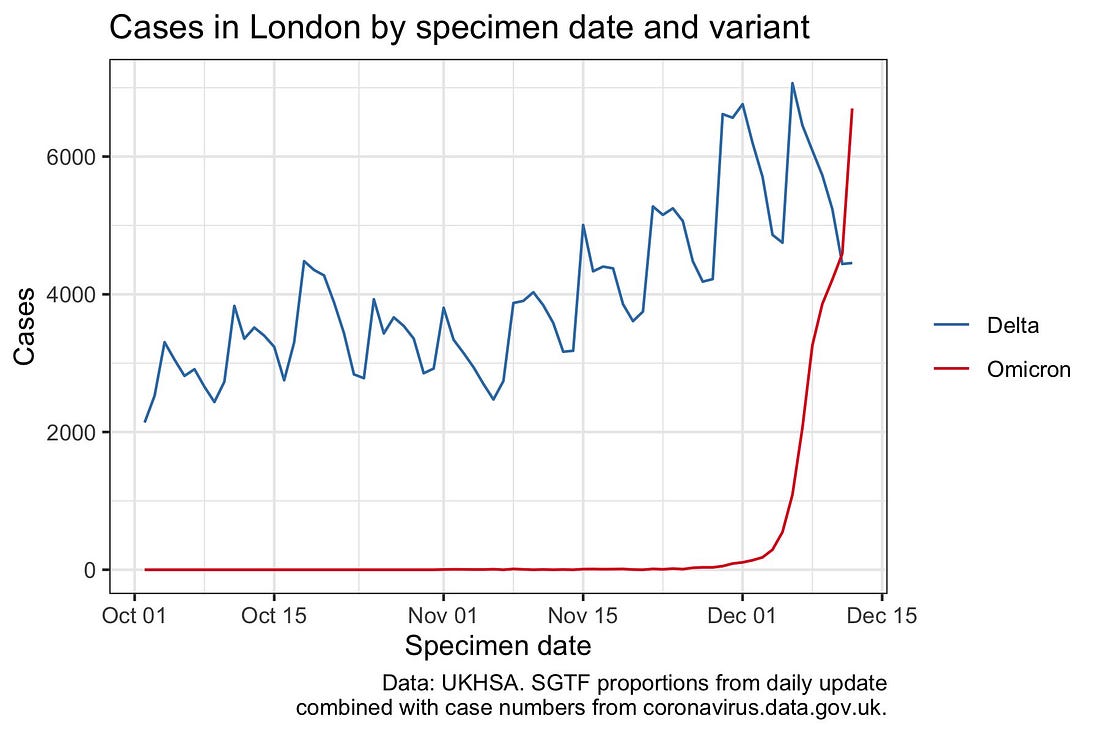

Other regions too, but not as dramatically, here’s the data source:

A day older but better labeled:
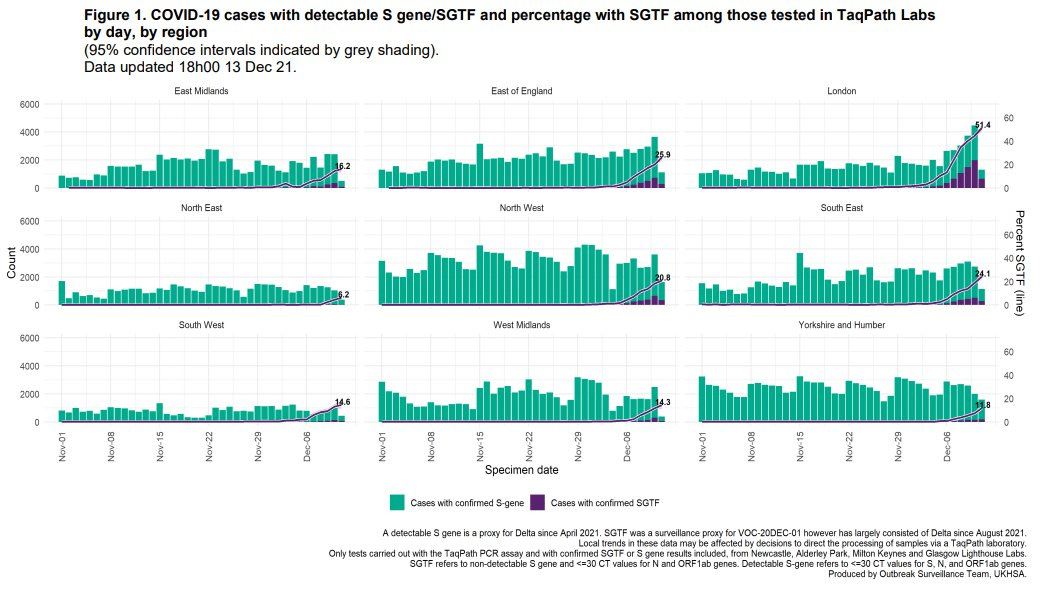
And finally another illustration for London from one day ago:
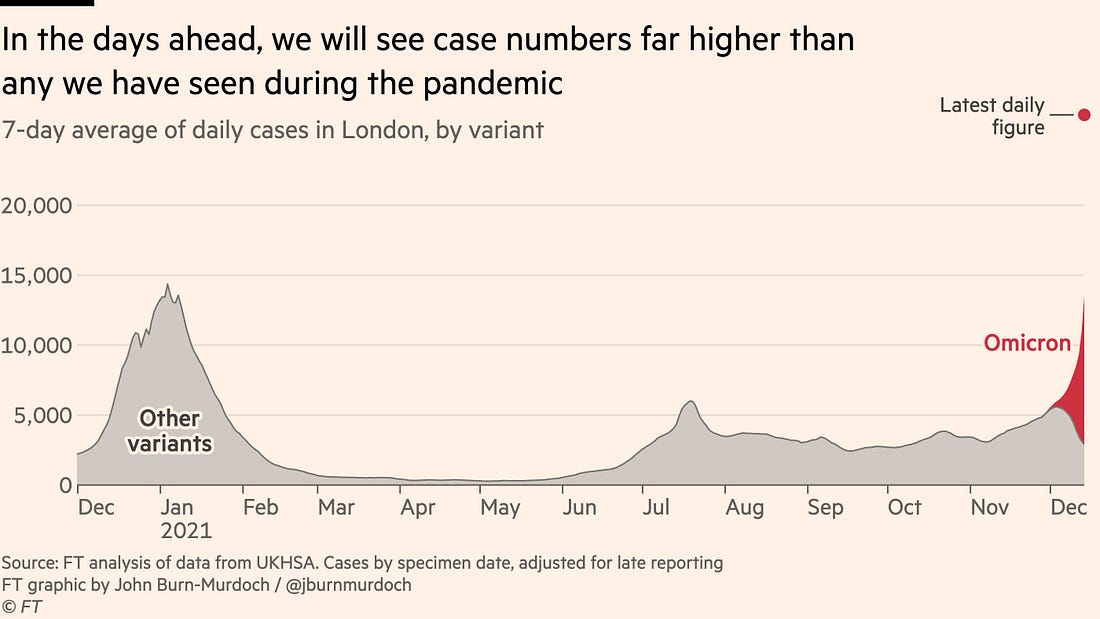
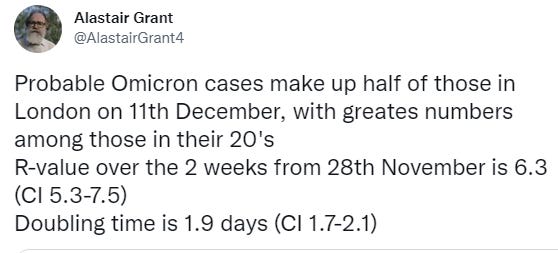
And the synthesis for the nation.
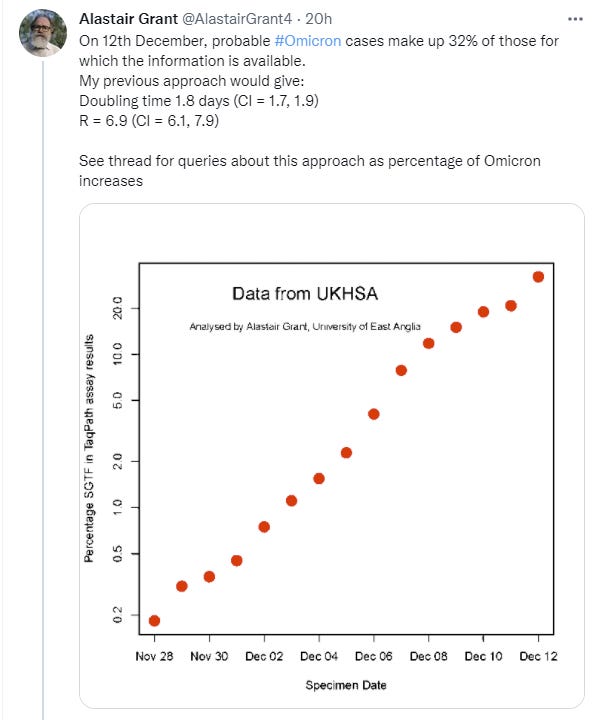

It’s a strange dynamic where Delta is stable in London and stable outside of London, yet in London Omicron goes vertical much faster than elsewhere. It’s a big hint as to how the physical dynamics work, with Delta cases in London even declining rapidly at this point as people adjust. But then again, maybe that’s simply a head start from more international travel, and I’m squinting at graphs wrong. Hard to say.
It also looks like London cases are spreading into older groups.
If you live in London, you have a choice to make right now that is similar to the one many others will likely have to make soon. Do you want to make a real effort to not be infected? We had over 30,000 reported cases in one day out of a population of 9 million or so, with a doubling time of every two days, with several days lag between infection and positive test. It’s reasonable to assume that the number of new infections is now more than 1% of the city per day and probably still increasing fast. If you go about your business as usual, you’re going to get infected. If you don’t want that to happen, extreme prevention measures need to happen now. The good news is that this is not sustainable – by definition you can’t have 1% infection rates per day for very long, and you can have 2% rates per day half as long as that, and so on, assuming no rapid reinfections occur. But it’s crunch time, and decision time.
Denmark



This is a good news style update, as I on average expected things to go faster than this. Best guess is that extra prevention is helping, although it shouldn’t help differentially against Omicron versus helping against Delta. Note the decline in Delta numbers starting on the 8th.

This continues to be our best information source. If things continue to be relatively under control here, that will be very good news.
Note that the UK data and Denmark’s data seem like they live in different universes, with very different relative R0s for Delta versus Omicron. It’s a mystery, and I don’t yet know how to reconcile them.
South Africa
The first real world results are in.

I’m running low on time, so not going to do a deep dive now, but there’s a great thread here for further analysis.
Elsewhere
General roundup of raw case counts:
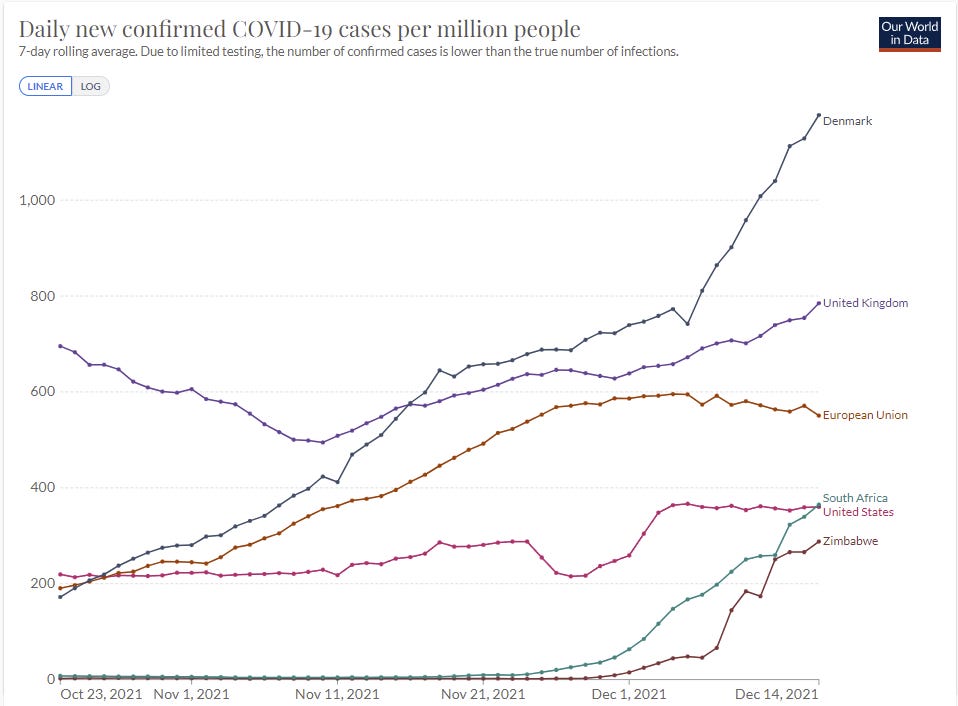
With time, better information sources are available in more places, so this is the round-up. To those who have been sharing sources in the comments, many thanks.
The CDC has a nowcast, which is more like a thencast given it reflects a bunch of lag, but it also appears to be a good faith attempt to synthesize the evidence and estimate what was happening in a given week.
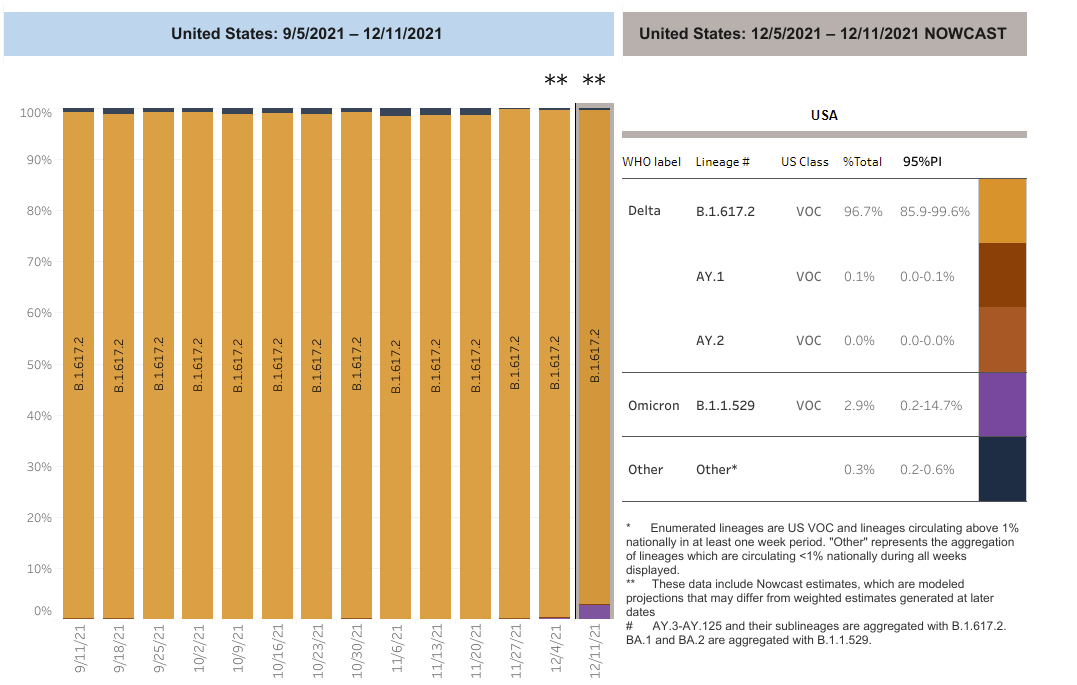
They have Omicron at 2.9% of infections already last week, after being only 0.4% the previous week, which is almost three doublings in seven days. Five days later, if trends continue, this predicts that we should already be at about 20% Omicron cases, because exponentials.
Here’s the word from Seattle. Here’s the University of Washington dashboard, for future reference, things are still too small to show up there, but here’s the SGTF graph. And here’s the updated word.
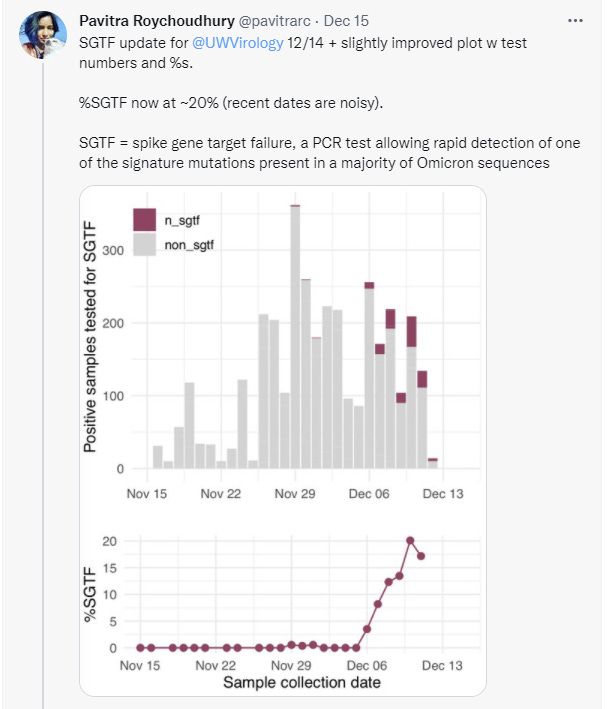
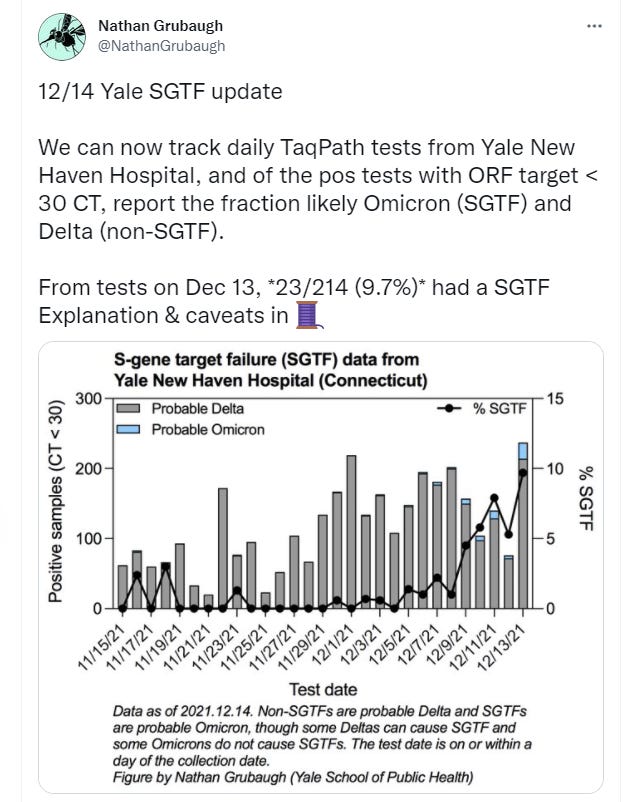



A doubling time of 3.8 days is actually super comforting and good news relative to other places. It can get way worse.
How much worse? Here’s the word from Ontario and all I can say here is holy f*** this is bad, that’s R0 = 7.7 when Delta would be stable, how in the world:
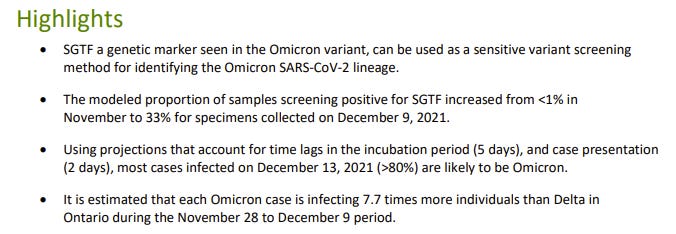

Given our other observations I’d happily take the under on 80%, or on the 7.7 multiplier, but if they’re even remotely close then there are no more reservations about how these exponential curves always blunt themselves and no the whole population won’t actually get infected by the end of February. If these numbers are accurate, it’s game over, man, game over. That doesn’t mean there’s nothing to be done, but it does mean you lose, good day sir, let’s try to do it with dignity and save as many people as we can.
Here’s an EU assessment of what’s likely to come, without predicting how many cases this is. It has the takeover point a week or two into January, which seems increasingly overly optimistic.
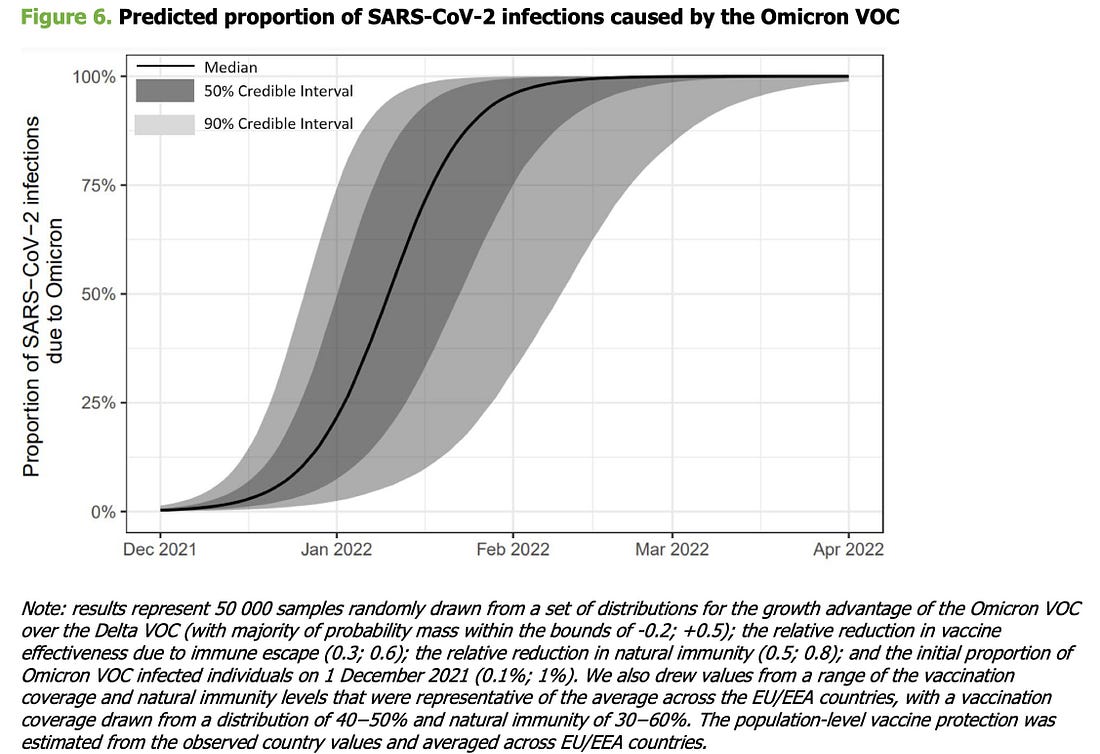
Kai gives a good thread summarizing the report. Here’s their projection for deaths:
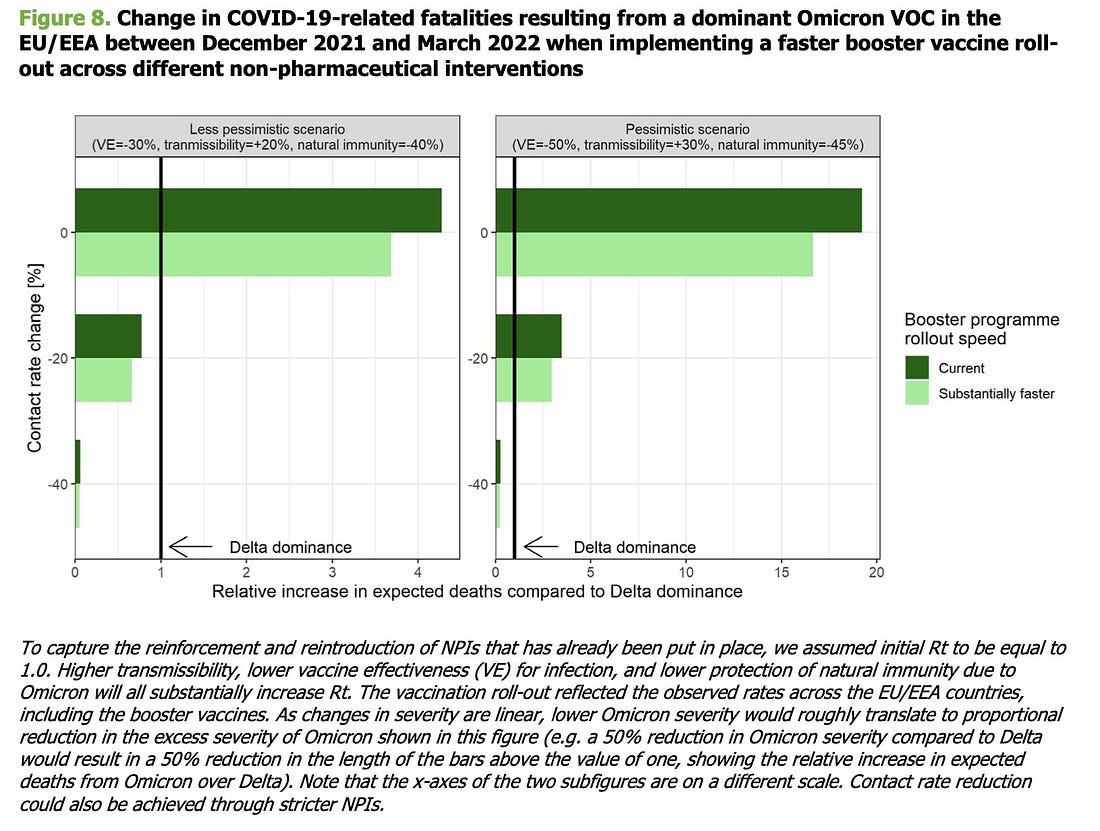
This is not an especially pessimistic scenario. It could happen, but it’s definitely nothing like the worst thing that could plausibly happen.
An interesting speculation on how information sources will change as things evolve.
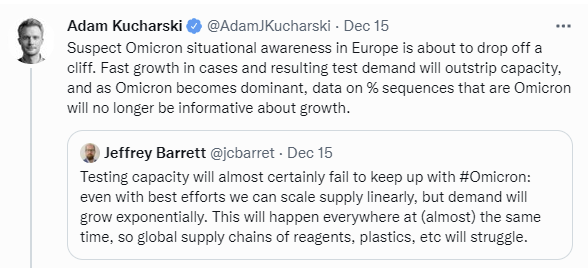

Even in the most optimistic scenarios we run out of tests, and have to adjust to things like positivity rate to estimate number of cases. However, the idea that hospitalizations will provide an alternative data source seems even less hopeful. The number of people in the hospital, even in relatively good scenarios, is going to be more a measure of how many beds there are in the hospital for patients to use, rather than a measure of how many people need those beds. In the good scenarios we manage to give everyone who sufficiently urgently and badly needs a bed a bad, but when we most need to know what’s going on, this won’t help us.
Deaths will tell us, but that’s a month in the rear view mirror, which is an eternity in context.
We’ll continue to get better data continuously everywhere for a while. Then when testing is overwhelmed, we’ll start to have to extrapolate. I still expect to better know where Omicron is at in a month than I do now, but we’ll be solving a very different set of puzzles to figure that out.
Here’s the variant data from Switzerland, which should be a better data source over time, for now maybe they’re behind and maybe they’re not measuring enough.
Omicron is spreading in China. Given their vaccination situation and lack of prior infections this could get ugly quickly. The techniques they used before likely won’t work now, although we’ve been wrong about that before. Definitely one to watch, but not much to go on yet.
The Lab on Vaccines
How effective are various vaccines against Omicron after various numbers of doses? We got some good data (paper).
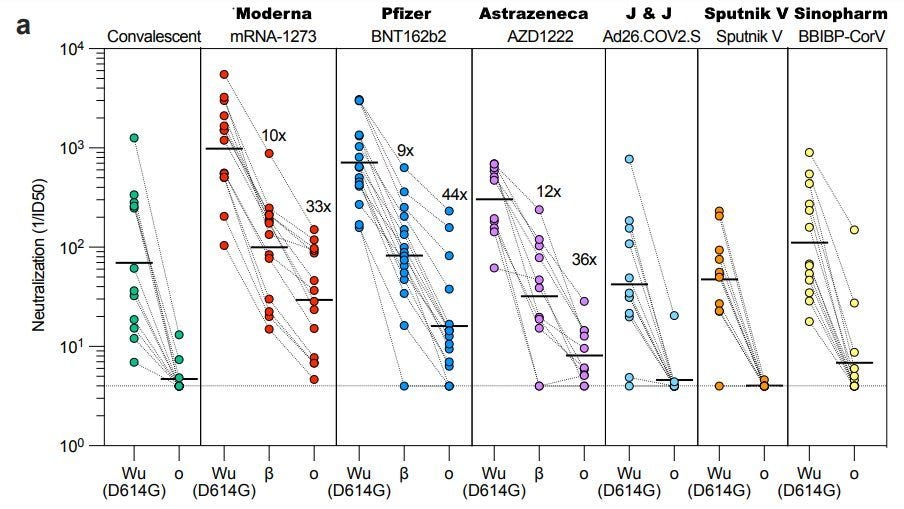


Here is a very good but long analysis thread of another study. Here’s a link to the lab’s thread. There’s lots of very good diagrams.



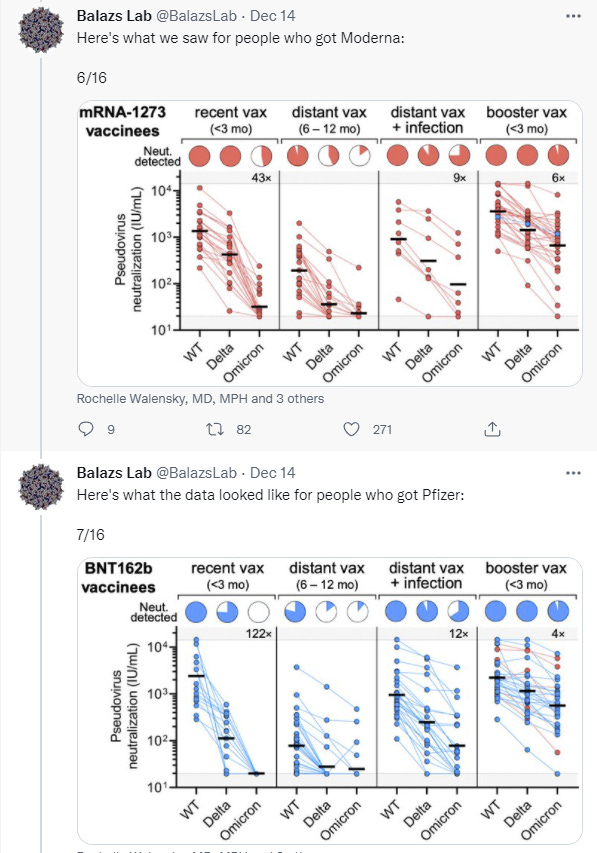

The Lab on Spread
We’re starting to get more color on why Omicron is spreading so fast. It’s not purely that it has escape properties. A lot more is going on. The graphs here are originally from the Balazs Lab study and thread.
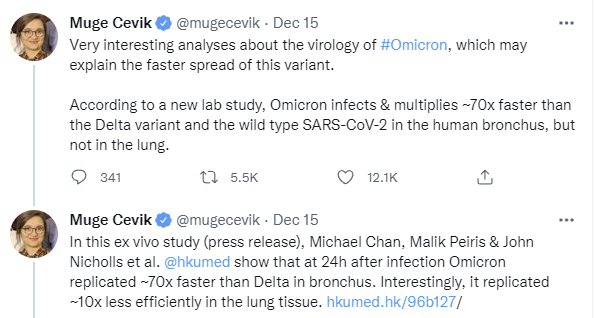
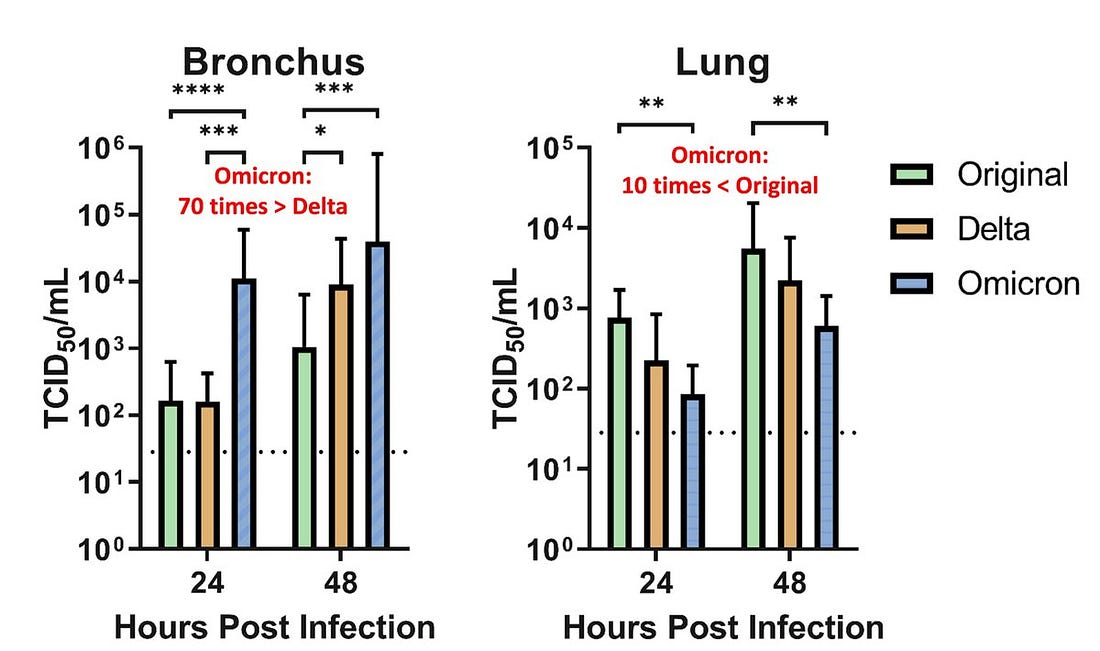




Severity
Andrew Lilley responds to arguments against his case that Omicron is indeed less severe even if you take into account all the other factors, in his analysis they can’t add up to enough and arguments otherwise are increasingly convoluted special pleading.
Official Statements
December 14 statements by Dr. Fauci on Omicron.
He nails the central question of virulence, for which we still lack clarity.
“The real question is, is that an inherent diminution of virulence of the virus or is it because there are so many people in the population who have already been infected and now have residual post-infection immunity — which is not protecting them from getting infected, but is protecting them from getting severe disease?”
He also is clear about what’s going to happen, up to a point.
“Whatever it is, the disease seems to be less severe. Whether it’s inherently less pathogenic as a virus or whether there’s more protection in the community, we’re just going to have to see when it comes in the United States. And for sure … it is going to be dominant in the United States, given its doubling time.”
What he isn’t then quoted as saying is anything regarding what happens when it does become dominant. There’s still pure denial about the size of the wave that is going to hit soon thereafter, and no attempt to prepare for it or reckon with the consequences. The correct answer could easily be to let it happen, but one still needs to be ready to do that.
It’s also worth noting that post changes even Fauci’s ‘is going to become dominant’ to a meaningless statement of what might happen, rather than an accurate statement of what will happen, by starting like this.
What will happen next with the omicron coronavirus variant? It might become the country’s most dominant COVID-19 strain, according to Dr. Anthony Fauci.
For some reason this kind of thing is happening a lot with Fauci in particular, where reporters change his words in ways that importantly distort their meanings. I notice it because he’s a simulacra-level-2 player whose words are intended to convey meaning and whose position makes those meanings important, so I parse them carefully. It’s possible that this position also makes reporters distort Fauci more readily, but I doubt this. It’s much more likely that this is standard procedure and reporters will report you as having said whatever they feel like, even when the direct quote provided says something different. They don’t believe words have meanings.
That’s one reason it’s often better to have transcripts, like this one from an interview Fauci gave on December 8. That’s a little old at this point but there are several telling passages. First, the attitude towards family gatherings, where vaccination makes life ‘possible’ and we are all called upon to police those around us:
Well, yes, that is just the reality of the situation. I mean, one thing vaccinated people can feel comfortable–for example, let’s take the holiday setting. You’re with your family. You have grandparents and parents and children. When you get vaccinated and you have a vaccinated group and you are in an indoor setting, you can enjoy, as we have traditionally over the years, dinners and gatherings within the home with people who are vaccinated.
And that’s the reason why people should, if they invite people over their home, essentially ask and maybe require that people show evidence that they are vaccinated, or give their honest and good faith word that they have been vaccinated.
Then there’s the new information, which is how he’s thinking about Omicron boosters.
You ask about the regulatory requirements. You know, I don’t want to step ahead of the FDA about what they would do, but I think in broad, contextual terms, if the level of protection with the boost against the original ancestral strain goes low enough–and whatever that cutoff point is–that’ll be up to the FDA, whether that’s below 50 percent or what have you. Then, it is likely we would need to at least look seriously at a variant-specific boost. But I hope we don’t need that. I hope we can continue to elevate the response by boosting with the original vaccine.
I’ve been in a few conversations about how to get Omicron boosters working faster, perhaps fast enough to get to the vulnerable before the wave becomes a tsunami, and had debates over whether that was the right focus. Everyone I know who thinks about this considers starting the process as fast as possible both important and a no brainer. Instead, everyone with any power over the situation seems to have suddenly decided that there’s no point, so it isn’t going to happen until far too late, and our entire ability to update the vaccines for a variant was effectively fake. We can’t actually do this until after we know we needed to have already done it. That’s marginally better than nothing, but it’s a lot closer to nothing.
It seems like, when there’s a strain that spreads three times as fast as the original or more, a vaccine that works about half the time is considered good enough, and good enough to force people to take it. This isn’t people modeling and thinking about the physical world and plotting exponential growth curves. This is moralistic thinking, or worse.
Finally, he makes it clear for those who weren’t sure that ‘fully vaccinated’ is a term of art that’s used to motte-and-bailey between ‘as much vaccination as would give you maximum protection’ and ‘what we require people to do or else.’
Well, you know, fully vaccinated is a technical term, Frances. It relates to the requirement of showing that you’re vaccinated to be able to go into a location, be it a college or a university or a workplace, to say I am now officially within this category so I can proceed. I don’t see that changing in the immediate future, but one thing is clear, that, from a personal standpoint, optimal protection is with a booster. When that gets changed to be the official definition of fully vaccinated, I think that certainly is on the table and is going to be seriously considered.
Response
What can we then do?
Here’s a thread about messaging to the people, pointing out that giving people ‘hope’ makes them more likely to support restrictions and adhere to guidelines. So you avoid showing them things like this projection from Denmark that was making the rounds last week.
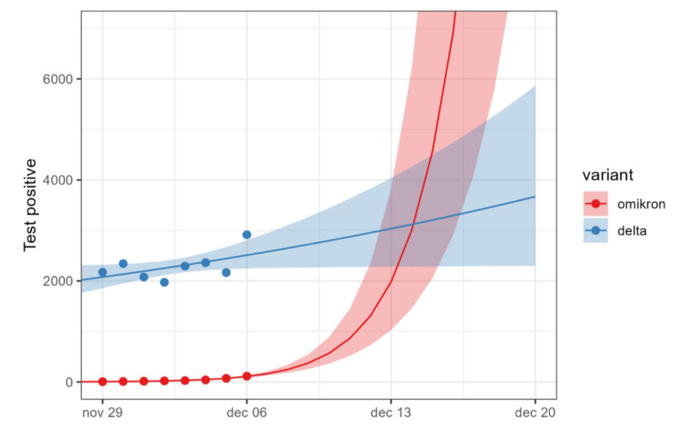
Instead you show them things like this, from messaging about Alpha.

With this result:

It’s good to know what is effective but what if there is no hope, and even with maximum realistic prevention it’s still a disaster? One response is ‘then we don’t want them adhering to the guidelines’ but you still do want people adhering to the right guidelines, whatever those are. Although if you’re standing outside the guideline-choosing process and they choose bad guidelines, as they likely will, then perhaps it would be better to have people ignore guidelines because the many of the guidelines are pointlessly destructive.
Here’s a thread covering the policy statement of the Global Preparedness Monitoring Board.

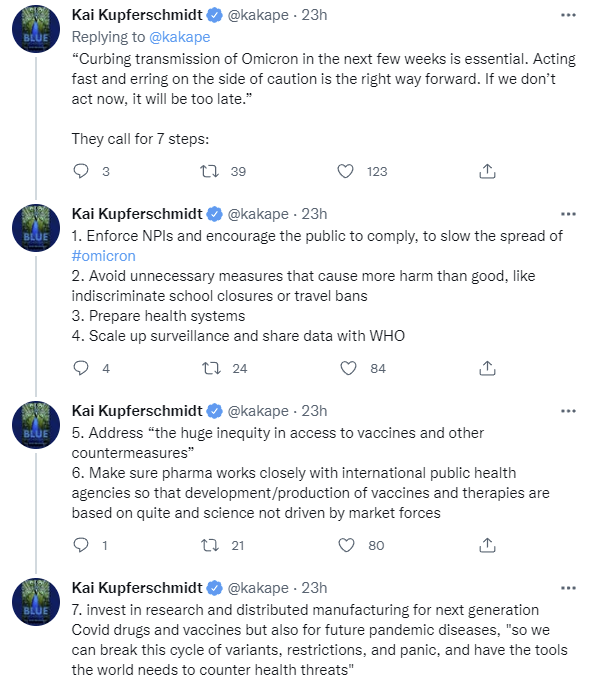
Once again, we have a generic call to, in Dido’s words, do the things we usually do. This is mostly the same measures they would have called for without Omicron. It contains nothing that has any hope of actually stopping Omicron. If you’re not willing to close schools, the game is already super over. Yes, it’s good to prepare the health systems and have good surveillance data available, and absolutely we should work on new vaccines and therapies and distribution of vaccines, that’s all very good, but how does all of that possibly help us in time?
The answer of course (aside from ‘prepare the system’ as best you can so it fails less hard, it’s simply not equipped for the scale of this) is that it doesn’t, but no one has anything else to do and one must Call For Action, so call for action it will be.
Kai notes in this thread that the UK seems to not be taking the WHO’s ‘vaccines and’ message to heart. I still don’t know what would be in the ‘and.’
Science article on what we know, seems reasonable but nothing new, once again downplaying the actually bad scenarios. Even when saying ‘I don’t think we got the message through’ I think ‘true, but I also think you didn’t get the message either.’
The Lab Leak Hypothesis Part 2
So, yeah. This happened.

This just dropped and I’m out of the time necessary to look into this for today. Maybe it’s all wrong, so don’t read too much into it until it’s been examined carefully.
But if this comes from a mouse I do not believe in that level of coincidence. There may not be a fire alarm for artificial general intelligence, but other things have constantly ringing really loud alarm bells and maybe we should stop doing the sort of thing that can lead to this outcome. The next time this happens we might not be so lucky. It has to stop.
It’s a developing story, so more on this later. For now, let’s wrap with the probability changes.
Probability Updates
Chance that Omicron has a 100% or bigger transmission advantage in practice versus Delta: 85% → 90%.
It’s pretty hard to look at the UK data and draw any other conclusion. I hold out the possibility that this is an early-stage thing enough that it might not break 100% exactly, but this doesn’t seem like an interesting question anymore, since at most we are ‘talking price’ and the better question is our best guess as to exactly how big an advantage. I’ll think about what the best replacement is.
Chance that Omicron is importantly more virulent than Delta: 3% → 3%.
Chance that Omicron is importantly less virulent than Delta: 60% → 60%.
The data from Denmark and South Africa point in opposite directions here. Saying ‘oh well they cancel out’ is the coward’s way out for sure, but until I have more time to process that’s where I am at. I’ll probably update at some point soon off no new information when I decide what it all means.
Will the CDC label Omicron a variant of high consequence before 2022? 11% → 11%.
I mean they should based on what I think it means, but whether or not they will doesn’t have much to do with that. Still waiting.
Chance we will be getting boosters modified for Omicron within 6 months of our previous booster shot: 50% → 30%.
Fauci is outright saying we don’t need an updated booster ‘at this time.’ That definitely kills any super rapid response but in the later part of the window it still seems plausible.
Chance we are broadly looking at a future crisis situation with widely overwhelmed American hospitals, new large American lockdowns and things like that: 25% → 35%.
The data in the UK and Ontario, and the data now coming in from various American cities, and the CDC nowcast, all point in the direction that this is happening fast. There’s no sign of a robust policy response anywhere, so maybe we really will let it burn, but I have no idea how we actually do it. Then again, I have no idea how we do another set of lockdowns. Something has to give. I notice that I don’t expect to do indoor dining (or, given the winter, much dining out at all) for much longer, but will it go further than that? I notice increasingly that I don’t have a good handle on how to think about the policy response that we’ll actually get because neither do any of the policymakers. I don’t think they’re thinking about it much at all.
Will Omicron be >1% of all cases by the end of the year? 97%+ → 99.9%+
This already happened. It’s done.